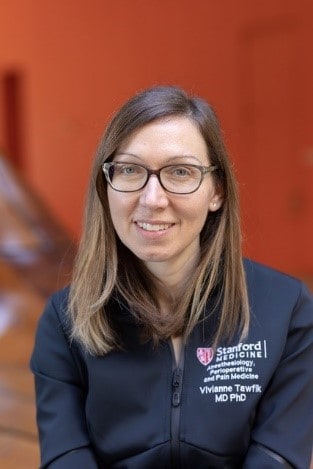Dr. Vivianne Tawfik, MD, PhD, is an Assistant Professor at the Stanford University Department of Anesthesiology, Perioperative & Pain Medicine in the United States. Her specialty is pain medicine and she has been in the pain field for 18 years. Vivianne has been an IASP member for five years and has attended two World Congresses.
How did you get into pain science? Did you always know it was what you wanted to do or did you start somewhere else?
As a teenager I lost a friend to a drug overdose and as a result I intended to study the mechanisms of drug addiction and become a psychiatrist. When I interviewed at Dartmouth for grad school I met my future PhD mentor, Dr. Joyce DeLeo and she explained to me that there was overlap between pain and addiction. This seems so obvious now, but at that time ~2001, not many people were thinking about those parallels. I joined her lab and was completely enamored with glia and their contribution to pain, never ended up studying addiction, and ultimately met other mentors along the way who shepherded me into Anesthesiology/Pain Medicine. Now I truly think I have the most amazing career because I am integrally involved in the care of patients with the same conditions that I research in the lab.
What topics does your current research/ clinical practice cover? How does this affect the public?
From a clinical standpoint, my expertise is in the management of chronic post-surgical pain and complex regional pain syndrome, a pain condition that develops after minor injury or surgery. These conditions have major implications for the public because there are huge number of surgeries performed every year and pain that is long-lasting after surgery or injury is under diagnosed and inadequately treated. My clinically-informed basic science research is really focused on better understanding these two conditions, figuring out the mechanisms that underly them and using that information to develop better treatments. We use a variety of approaches in this work including transgenic mouse models, RNA sequencing of various cell populations (glia!), behavioral pharmacology and small animal longitudinal PET imaging. The work I do in the clinic informs our science and vice-versa!
Why did you become an IASP member?/ Why are you an IASP member?
I always felt that IASP really brought together all the pain experts in one place. As a physician-scientist myself, it’s so meaningful for me to have a community of physicians, researchers, psychologists, physical therapists, all the people who treat and research pain, in one place.
What is your favorite member benefit?
Definitely the IASP World Congress! There are so many amazing sessions and (in non-pandemic times) it’s a wonderful opportunity to network and learn.
What is the last book you read for fun?
The only books I read for fun these days are with my sons (ages 4 and 7), so the most recent book I read was “Tales of an 8-bit kitten: Lost in the Nether” by Cube Kid. It’s safe to say I understood about 1/4 of the words I read and needed to pause after each page for my 7 year old to explain to me what was happening in the Minecraft-based story!
What are the top 3 words your best friend would use to describe you?
I literally asked them because I really wasn’t sure! Per my friends who did residency with me and therefore spent an inordinate amount of time with me at all hours of the day/night: compassionate, funny (ok I added this one!), committed, brilliant, persistent, loyal, altruistic
Interested in becoming a member of IASP?
With your IASP membership, you gain access to:
- PAIN Journal
- Pain Education Resource Center (PERC)
- Access to 24 Special Interest Groups (SIGs)
- Online Career Center access
- Discounts on World Congress
- Network of thousands of pain researchers from around the world!
Membership dues are determined by income, the rates of membership can be found at this page of our website.


